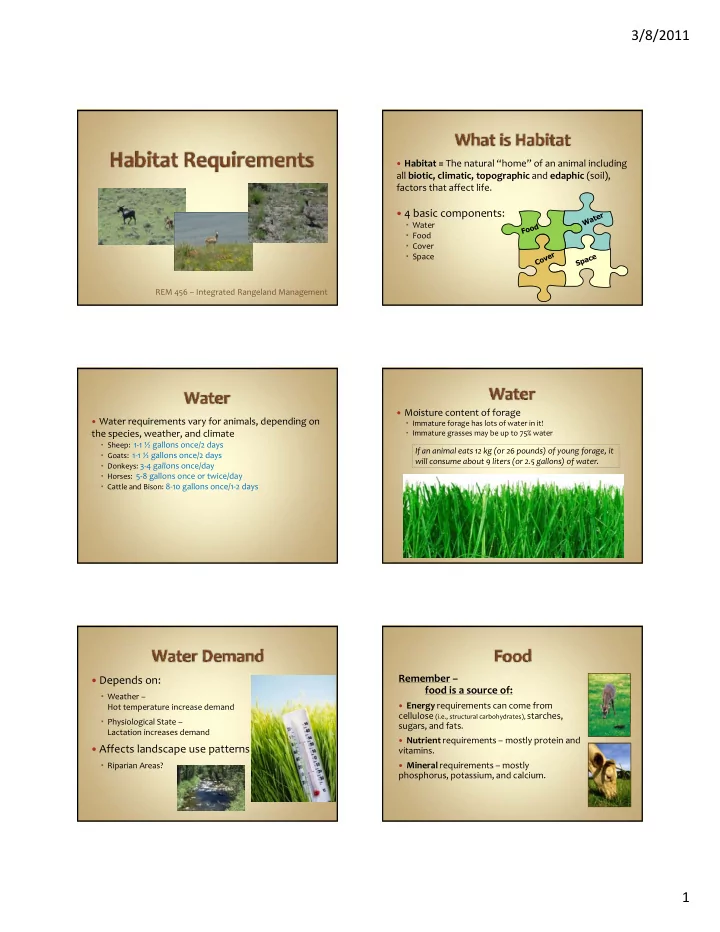

3/8/2011 � Habitat = The natural “home” of an animal including all biotic, climatic, topographic and edaphic (soil), factors that affect life. � 4 basic components: � Water � Food � Cover � Space REM 456 – Integrated Rangeland Management � Moisture content of forage � Water requirements vary for animals, depending on � Immature forage has lots of water in it! the species, weather, and climate � Immature grasses may be up to 75% water � Sheep: 1 ‐ 1 ½ gallons once/2 days If an animal eats 12 kg (or 26 pounds) of young forage, it � Goats: 1 ‐ 1 ½ gallons once/2 days will consume about 9 liters (or 2.5 gallons) of water. ( g ) f � Donkeys: 3 ‐ 4 gallons once/day � Donkeys: 3 4 gallons once/day � Horses: 5 ‐ 8 gallons once or twice/day � Cattle and Bison: 8 ‐ 10 gallons once/1 ‐ 2 days Remember – � Depends on: food is a source of: � Weather – � Energy requirements can come from Hot temperature increase demand cellulose (i.e., structural carbohydrates), starches, � Physiological State – Physiological State sugars, and fats. d f t Lactation increases demand � Nutrient requirements – mostly protein and � Affects landscape use patterns vitamins. � Riparian Areas? � Mineral requirements – mostly phosphorus, potassium, and calcium. 1
3/8/2011 The amount of food required by rangeland � Preferred : more abundant in an animals diet animals varies with the type of animal: compared to availability in the field. � Staple: eaten on a regular basis and meet the � Concentrate selectors such as birds, bears, and nutritional needs, but not sought or preferred. , g p mice will eat 0.25% of their body weight per day mice will eat 0.25% of their body weight per day � Emergency : eaten only rarely to fulfill short ‐ term � Ruminants such as bison, deer, cattle, and sheep nutritional needs; foods have some forage value. will eat 2.5% of their body weight per day � Fill : eaten only if nothing else is available, would not � Hind ‐ gut fermenters such as horses and rabbits meet animal needs. will eat 3.0% of their body weight per day � Evaluate land on basis of food requirements: � Thermal � Must know vegetation present � Shade in summer � Must also know diet preferences � Shelter from & requirements of animal cold wind in winter � Also must evaluate spatial arrangement of food. Examples from Utah Rangelands: http://extension.usu.edu/utahrangelands/htm/wildlife/ � Hiding ‐ Protection from predators � Hiding ‐ Protection from predators � Vegetation as visual obstruction � Lack of visual obstruction (i.e., pronghorn and prairie dogs) 2
3/8/2011 Habitat selection = The act of selecting specific Important consideration for: habitat among habitats � Breeding and nesting � Home range � Potential Range = Any area that contains all elements � Territories necessary for growth and Reproduction � Social intolerance � S et by limiting factors = any basic requirement that � Disease transmission limits the size growth, and or quality of an animal population. � Water � food � Climate � Topography � Home Range = the area in which an individual animal conducts its normal annual activities � Human impact on limiting factors � Remove limiting factors � Add limiting factors www.vis sitidaho.org www.stanleyparkecology.ca � Territory = an area that an animal will defend (usually � Home Range = the area in which an individual animal for breeding or rearing young) conducts its normal annual activities � is exclusive to individual � can be shared with other individuals or unit (i.e., pack) � directly related to body weight � carnivores > omnivores > herbivores i i h bi � varies by diet habits � human encroachment has greatest effect on animals with large home ranges http://forums.yellowstone.net 3
3/8/2011 � Philopatry = the “love” for a particular place, usually � Why do animals select home ranges or territories? referring to one’s homeland or place of rearing. In some � It allows animals to be familiar with food resources and develop species, like salmon, philopatry is so strong that no place foraging skills � Results in increased knowledge of cover to decrease risk of but that place is acceptable. predation. � Predation = habitat selection must take into account the � Any disadvantages? risk of predation in habitat. � Quality of information = Perfect habitat selection requires perfect habitat information. This is not possible because animal do not know: � all appropriate habitat available � may not be able to assess habitat quality � of may not know the risk of predation � What natural events challenge the quality of wildlife habitat? � � � � � What human activities challenge the quality of wildlife habitat? � � � � 4
Recommend
More recommend